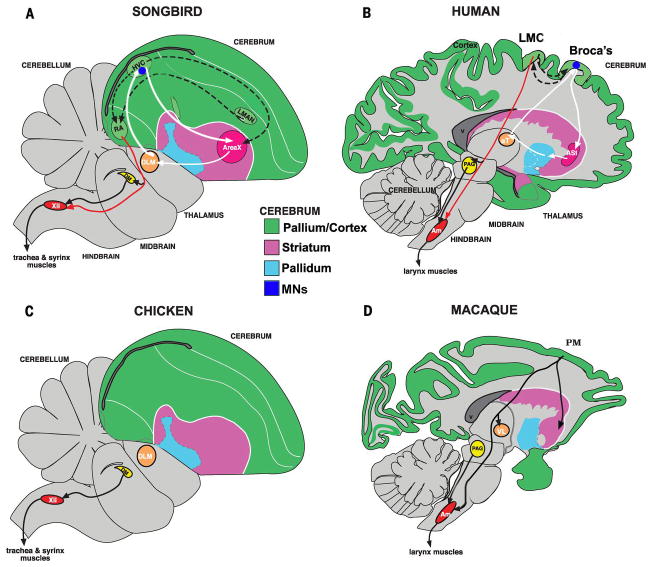Fig. 2.
Actual and potential vocal learners and audio–vocal mirror neurons (MNs). Songbirds and humans, both vocal learners, have a similar pattern in the way premotor/motor areas are connected to the brainstem in the establishment of learned vocalizations. In songbirds (A) the robust nucleus of the arcopallium (RA) connects with motoneurons of the syrinx (XII) for the production of song, while a preparatory and modulatory role is played by the premotor nucleus high vocal centre (HVC), which is also implicated in the circuit underlying learning vocalizations together with the striatal nucleus (Area X) and the dorsolateral nucleus of the medial thalamus (DLM). Similarly, in humans (B), the face area of the primary motor cortex (the region involved in laryngeal motor control; LMC) connects to the nucleus ambiguous (Am), while Broca’s area, a premotor region, is thought to play a more anticipatory and planning role, and is though to be implicated in vocal learning together with the anterior striatum (Ast) and the anterior thalamus (At) (considered homologous to Area X and the DLM, respectively). Audio-vocal MNs have been found in the HVC and Broca’s area, respectively, in songbirds and humans. In non-singing birds or female songbirds (C), which lack vocal learning, the circuit controlling innate calls involves connections between the periacqueductal grey area (PAG) [the avian homolog to the dorsal medial nucleus of the midbrain (DM)] and motoneurons of the syrinx and larynx. A similar circuit has been described in non-human primates, such as the macaque (D), where connections between the PAG and the motoneurons of the Am are necessary, together with the anterior cingulate cortex (ACC), to produce emotionally spontaneous vocalizations. By contrast, the lateral part of the cerebral cortex of non-human primates, the premotor cortex, has a minor role in voluntary control, despite its most lateral part having motor representations of the mouth and larynx. Nevertheless, both female songbirds and macaques can be trained to vocalize voluntarily and consequently to establish connections between the premotor cortex and motoneurons, and therefore have the capacity to develop audio–vocal MNs in the premotor regions. The red arrow shows the direct motor projection from vocal motor regions (RA or LMC) to the brainstem (XII or Am). The white arrow represents the cortico-striatal loop for learning vocalizations, while the black arrow shows the conserved pathway for innate calls. The dashed black arrow shows possible connection between the cortico-striatal loop for learning and the direct motor projection involved in the production of vocalizations. LMAN, lateral magnocellular nucleus of the anterior nidopallium; VL, ventrolateral thalamus [considered homologous to the AT]; PM, premotor cortex. Modified from Pfenning et al. (2014).

